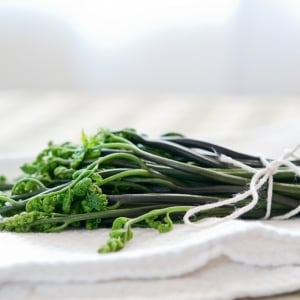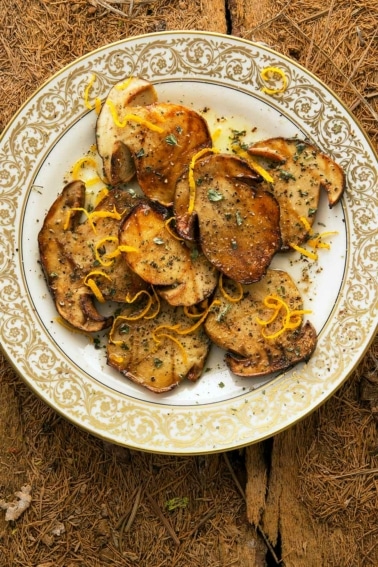As an Amazon Associate I earn from qualifying purchases.

I eat a known carcinogen every spring. But then again, chances are, so do you.
Few wild plants are as polarizing as bracken fern, Pteridium aquilinum. It is a global species, living everywhere but the harshest deserts and the coldest tundra. Here in California, it is ubiquitous. I find its fiddleheads — odd looking fiddleheads, like an eagle’s clenched talon — in Point Reyes as early as late February and as late as mid-June in the High Sierra.
That means if you wanted, you could eat bracken fern fiddleheads for four straight months here in California. You could, but you shouldn’t.
Bracken fern does indeed contain a carcinogen, that much is clear. It also contains an enzyme that makes Vitamin B1 less available to the body, so chronic consumption of bracken can lead to nastiness like beriberi. I’ve spent a lot of time over the years reading scientific papers with names like “Induction of Tumors in ACI Rats Given a Diet Containing Ptaquiloside, a Bracken Carcinogen.”
Breezy reading, this. But the slog has been worth it, if only because I refuse to trust the internet and my fellow foraging writers outright. Bracken is so controversial you will see them writing statements ranging from “eat it as much as you want, it’s fine,” to “never, ever, ever eat bracken, raw or cooked.”
And like most black-and-white statements, both are wrong.
After a pretty exhaustive — and exhausting — survey of the literature, it seems pretty clear that a typical forager’s diet of bracken fiddleheads, blanched and sauteed with lots of butter (or whatever) is perfectly safe. Before you start shouting at me, let me explain.
The primary villain lurking within bracken fern is a substance called ptaquiloside. It is, by all accounts, nasty stuff. And bracken fiddleheads are packed with it, up to 0.8 percent by dry weight, according to some studies. But therein lies the first caveat: A raft of other studies shows that ptaquiloside levels vary wildly in bracken stands. Some in New Zealand were even found with none of the stuff at all. So you really have no idea how much — if any — of the carcinogen lies within your pretty fiddlehead.
It is abundantly clear, however, that if you eat raw bracken fiddleheads in the woods you will probably ingest ptaquiloside. And that’s not good eats.
But ptaquiloside has three properties that are of interest to us:
- First, it is not actually a carcinogen, according to the latest research. But it is volatile, and likes to react in alkaline environments to create what is now suspected of being the true carcinogen, a substance called dienone. This is why drinking milk from animals that have been eating a lot of fiddlehead fronds is a very bad idea; milk, and the healthy stomach of a ruminant, is basic enough to cause the ptaquiloside to transform into dienone.
- Second, ptaquiloside is water soluble. That means if you soak bracken fiddleheads in cool water (cool to keep them crunchy), and change that water every so often, you will greatly reduce the level of this nasty substance in the fiddlehead; the Japanese often eat bracken this way.
- Third, ptaquiloside is notoriously volatile at normal temperatures. The pure stuff degenerates at room temperature, which is why the scientists doing the rat studies store their ptaquiloside at -20° Celsius. Once exposed to boiling temperatures, the carcinogen denatures almost completely. Salt increases this effect.

Virtually all the data on the subject link most human health problems associated with bracken fern to exposure to contaminated milk from animals eating bracken, contaminated groundwater near bracken stands, and, in some cases, long-term exposure to bracken spores; so if your yard is covered in bracken fern, you might want to dig most of it up.
What all this means is that a very normal cooking process for fiddleheads — blanching in salty water, then shocking in ice water, then sauteeing — renders the fiddlehead close to harmless.
Note that I say “close to harmless.” Even though most of the research out there suggests that normal human methods of eating bracken, which, incidentally, has been eaten by cultures across the globe since prehistory, denature or render harmless what ptaquiloside exists in a bracken fiddlehead, there is one nagging piece of data out there: There is an apparent link between chronic consumption of bracken and an increased level of throat and gastric cancers in the populations of Korea, Japan and parts of China. Bracken is widely eaten in Korea, Japan and parts of China. And when I mean “widely,” I mean almost every day in some cases. Bracken (gosari) is a classic part of bibimbap, one of the most famous Korean dishes there is.
Most of the research on this has been done by Japanese and Koreans, searching for clues as to why they seem to have high rates of throat and stomach cancer. Apparently there are a kaleidoscope of reasons, and habitual bracken-eating is among them. Like anything, ptaquiloside’s poison is in the dose. According to my reading of the research, the body apparently can process out only so much of the stuff, and constant eating of bracken puts too much in the system, and that’s what causes cancer.
I know what you are saying. Why even mess with this crazy bracken thing? Why even put myself at risk?
Several reasons. First, bracken tastes wonderful, like asparagus, almonds and Tuscan black kale all rolled into one. Second, eating bracken is akin to drinking alcohol: Done responsibly, it is enjoyable and perfectly safe. But just as you would not rationally decide to drink a case of beer every day for a month, you would not rationally choose to eat a big plate of bracken ferns every day during the fiddlehead season.
I choose to eat bracken fiddleheads. How often? Maybe a half-dozen times a year. Eat them once and you will see what all the fuss is about, and make your own decision. Just remember your Aristotle: All Things in Moderation.
If you do pick your own bracken fiddleheads, choose those that are not fully extended. You want them either in the horseshoe bend or at least tightly closed. Remember, the eagle’s talon should be clenched, not open. Do not eat them once their fronds unfurl.
Buttered Bracken Fern
Ingredients
- 3/4 to 1 pound young bracken fiddleheads
- Salt
- 3 tablespoons truffle butter, or regular butter
Instructions
- Trim the bracken fiddleheads to an even length. Bring a large pot of water to a boil and add enough salt to make it taste like the sea. Fill a large bowl with ice water. Boil the bracken for 2 minutes, then plunge into the ice water. let them sit in the water for 45 minutes to 1 hour. Discard the water. Pat dry.
- Heat half the truffle butter in a large saute pan over medium-high heat. Saute the fiddleheads for 4 to 5 minutes, flipping them from time to time. Sprinkle some salt over them. Turn off the heat and add the remaining butter. Swirl to coat the fiddleheads with the butter as it melts. Eat at once.
Nutrition information is automatically calculated, so should only be used as an approximation.





I second this request. I am not doubting the author, he has certainly dug deeper than I! Sources are an essential way to present information, and certainly, specific temperature and time numbers were present in the literature.
Is bracken no longer edible if their shoots are open?
Helen: I learned that you only want to pick the youngest shoots, and that the mature ferns are much more toxic.
Hello, love this recipe.. i live in australia, but in my country indonesia, we eat bracken often too, mostly stirfry, or steam. Thanks for extended information.
My Japanese grandmother would soak the young bracken overnight in water with baking soda. I wonder if the baking soda neutralizes and/or the water draws out the ptaquiloside?
The baking soda would create an alkaline environment which like milk would encourage its dissolution according to the author, so definitely!
Interesting article. But I’m surprised that you think one of the reasons Koreans getting cancer is eating brakens. I’m Korean and no Korean would eat them daily.
There are way more convincing reasons for Koreans getting cancer.
They are extremely stressed out from overworking in a crazy competitive environment, eat very spicy foods, often drink a lot and not get enough sleep.
That’d be more appropriate reasons for Koreans getting throat and stomach cancer.
They’re not stupid and actually a lot more careful about what food is good for them or bad than most western people.
Usually brakens are blanched and dried for storage, dehydrated by being soaked for hours, boiled and soaked again before being cooked in Korea.
As you said, most of the bad stuff will be gone by this time and again, few Koreans eat brakens that often and that much.
Julia: I was going off what the researchers were theorizing. I don’t know enough about the eating habits of regular Koreans to make an educated guess beyond what the scientific literature says.
Some Koreans do not eat brakens daily, but in some rural regions with abundant free sources of brakens, they do, and accordingly have higher instances of gastrointestinal cancer when controlled for other factors. Researchers are not stupid either. Gastrointestinal cancer in the Korean and Japanese populations is one of the most extensively researched topics in medicine and many factors are taken into account. Currently, the most accepted theory is in fact genetic factors, but braken consumption is considered as one of the modifiable factors.
Frederich: Good to know, thanks! I wrote this article a long time ago, so I am guessing there is substantial new evidence out there.
This was great! Thanks for doing the deep digging for us. I swore off the brackens a few years back. Though they tempt me each spring. Today I picked a handful and was looking for a way to process and there you were. Thanks again!
Hello, I enjoyed reading your article. You speak of ‘exhaustively’ surveying the literature, but you present no references for your claims. Please share the sources for your claims. For example, that ptaquiloside is destroyed by heat? How much heat? For how long? Destroys how much ptaquiloside? Thank you